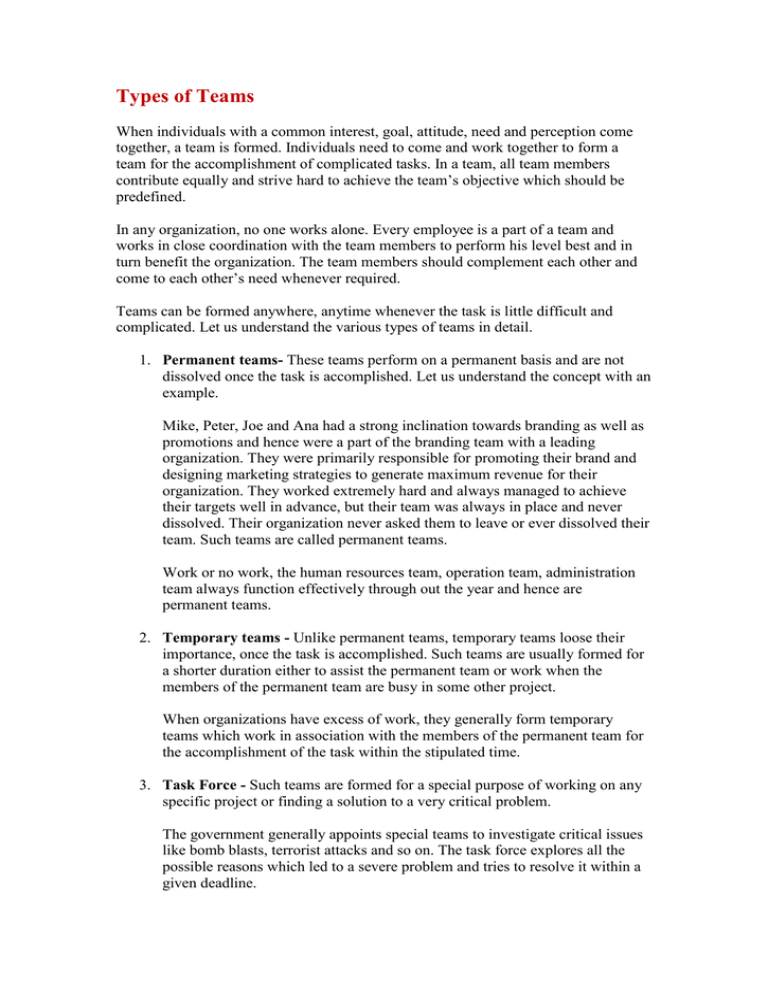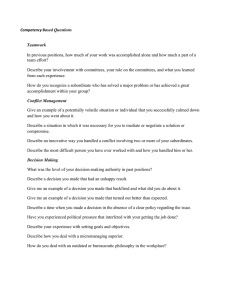Types of Teams
advertisement

Types of Teams When individuals with a common interest, goal, attitude, need and perception come together, a team is formed. Individuals need to come and work together to form a team for the accomplishment of complicated tasks. In a team, all team members contribute equally and strive hard to achieve the team’s objective which should be predefined. In any organization, no one works alone. Every employee is a part of a team and works in close coordination with the team members to perform his level best and in turn benefit the organization. The team members should complement each other and come to each other’s need whenever required. Teams can be formed anywhere, anytime whenever the task is little difficult and complicated. Let us understand the various types of teams in detail. 1. Permanent teams- These teams perform on a permanent basis and are not dissolved once the task is accomplished. Let us understand the concept with an example. Mike, Peter, Joe and Ana had a strong inclination towards branding as well as promotions and hence were a part of the branding team with a leading organization. They were primarily responsible for promoting their brand and designing marketing strategies to generate maximum revenue for their organization. They worked extremely hard and always managed to achieve their targets well in advance, but their team was always in place and never dissolved. Their organization never asked them to leave or ever dissolved their team. Such teams are called permanent teams. Work or no work, the human resources team, operation team, administration team always function effectively through out the year and hence are permanent teams. 2. Temporary teams - Unlike permanent teams, temporary teams loose their importance, once the task is accomplished. Such teams are usually formed for a shorter duration either to assist the permanent team or work when the members of the permanent team are busy in some other project. When organizations have excess of work, they generally form temporary teams which work in association with the members of the permanent team for the accomplishment of the task within the stipulated time. 3. Task Force - Such teams are formed for a special purpose of working on any specific project or finding a solution to a very critical problem. The government generally appoints special teams to investigate critical issues like bomb blasts, terrorist attacks and so on. The task force explores all the possible reasons which led to a severe problem and tries to resolve it within a given deadline. 4. Committee - Committees are generally formed to work on a particular assignment either permanently or on a temporary basis. Individuals with common interests, more or less from the same background, attitude come together on a common platform to form a committee and work on any matter. To organize any cultural event, organizations generally make committees to raise funds, invite celebrities and all the major tasks involved to successfully organize any event. The committee members work together, design strategies to successfully accomplish the task. In educational institutes, various committees are formed where students with a common interest join hands to organize cultural events and various other activities required for the all round development of students. 5. Organization/Work Force - Such groups are formed in organizations where team members work together under the expert guidance of leader. A leader or a supervisor is generally appointed among the members itself and he along with his team works hard to achieve a common goal. The leader all through must stand by his team and extract the best out of each team member. He must not underestimate any of his team members and take his team along to avoid conflicts. Samuel was working with a leading advertising firm with two members reporting to him. Samuel always believed in his team members and worked together with his team and no doubts his team always did wonders and was way ahead of others. 6. Self Managed Teams - Self Managed Teams consist of individuals who work together again for a common purpose but without the supervision of any leader. Here as the name suggests every individual is accountable for his individual performance. The team members of self managed teams must respect each other and should never loose focus on their target. No leader is appointed and the team members have to take their own responsibility. Individuals take the initiative on their own and are their own guides and mentors. 7. Cross Functional Team - Let us understand this with the help of an example. Maria and Andy both were part of the branding team. They got an assignment from their superiors to be completed within two days. Unfortunately Andy met with an accident and was advised complete bed rest. To avoid delays, Peter from the operations team was shifted to the marketing team to assist Maria for the time being and form a team. Such teams are called cross functional teams. Ideally the employees should be more or less on the same level to avoid ego hassles. Individuals from different areas come and work together for a common objective to form a cross functional team. In such teams, people from different areas, interests and likings join hands to come out with a unique idea to successfully complete a task. 8. Virtual Teams - Virtual teams consist of individuals who are separated by distances and connected through computer. Here individuals communicate with each other online through internet. Sam at Los Angeles can form a team with Mandy at Mexico and Sara at Denver all working for a common objective but the communication is totally digital through internet. Such teams are helpful when employees need to connect with each other and are located at different places. Individuals supporting any community in social networking sites such as facebook or orkut also form a virtual team as all the members are from different locations but support a common community. They all have a common objective -to support and promote their community. http://www.managementstudyguide.com/types-of-teams.htm


